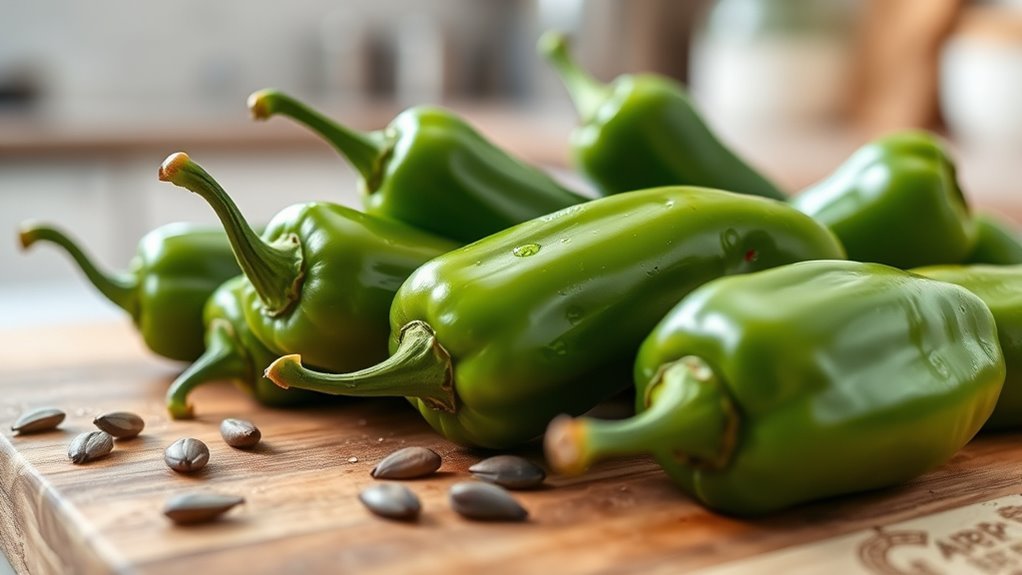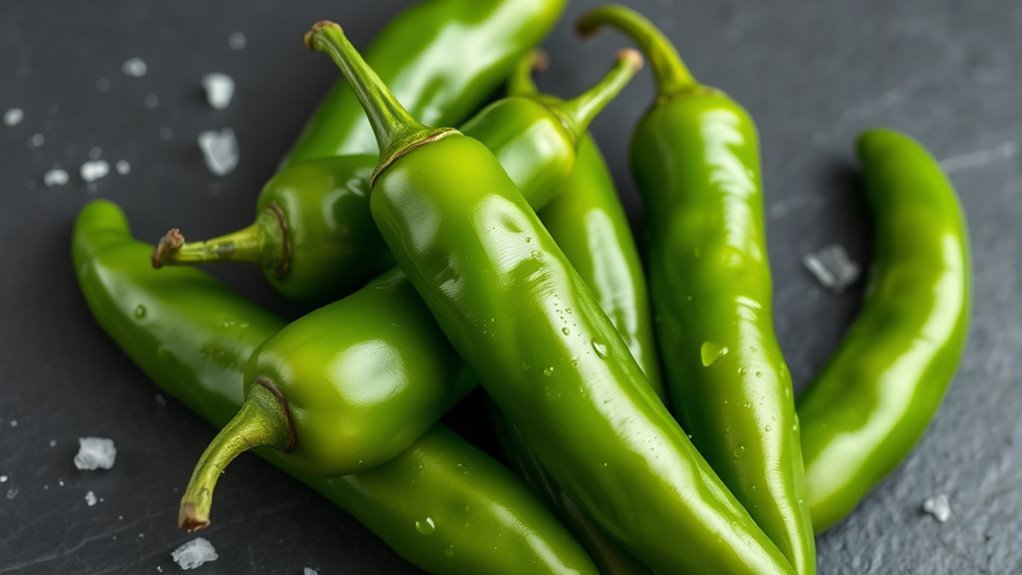Yes, jalapeños are keto-friendly! With only about 1 gram of net carbs per medium-sized pepper, they fit well within your carb limits. They’re rich in vitamins A, C, and K, and contain capsaicin, which could boost your metabolism. Plus, they add great flavor without significant calories. If you’re curious about how to incorporate jalapeños into your meals or learn more about their benefits, there’s plenty more to explore!
Understanding the Keto Diet

When you’re exploring the keto diet, it’s important to understand its foundational principles. The keto basics center around drastically reducing carbohydrate intake while increasing fats, pushing your body into a state of ketosis. This metabolic shift enables the body to burn fat for fuel instead of carbs, potentially leading to weight loss and better energy levels. However, diet misconceptions abound, often portraying keto as merely a high-fat diet. In reality, the focus is on quality fats and moderate protein intake. Understanding these principles not only clarifies the diet’s intention but also empowers you to make informed choices. By grasping the science behind keto, you can embrace a lifestyle that prioritizes both freedom and health, while avoiding common pitfalls.
Nutritional Profile of Jalapeños

Understanding the keto diet’s emphasis on low carbohydrate intake is key to evaluating foods like jalapeños. These vibrant peppers, available in various jalapeño varieties, offer more than just heat; they’re packed with nutritional benefits. A typical jalapeño is low in calories and rich in vitamins A, C, and K, supporting immune function and skin health. They also contain beneficial compounds like capsaicin, which may boost metabolism and promote fat burning. Additionally, jalapeños are a good source of dietary fiber, aiding digestion. Incorporating these peppers into your meals can enhance flavor without compromising your carb limits, making them an excellent choice for those seeking freedom in their ketogenic lifestyle. Enjoy the spice while reaping the rewards!
Carb Content in Jalapeños

Jalapeños contain a surprisingly low amount of carbohydrates, making them a suitable option for those on a ketogenic diet. Typically, a medium-sized jalapeño has around 1 gram of net carbs, which allows you to enjoy their spicy flavor without compromising your carb count. When considering different jalapeño varieties, such as the milder Fresno or the hotter Serrano, the carb content remains relatively consistent, with only slight variations. Even if you’re adding them to dishes or salsas, their low carb profile helps keep your overall carbohydrate intake in check. This makes jalapeños not just a flavorful addition to meals but also a freedom-friendly choice for anyone looking to maintain a keto lifestyle.
Health Benefits of Jalapeños
While many people might focus solely on the flavor that jalapeños bring to dishes, their health benefits are equally significant. These vibrant peppers are packed with nutrient density and provide a wealth of advantages for your well-being. Here are three key benefits:
- Rich in Vitamins: Jalapeños are high in vitamins A, C, and K, which support immune function and skin health.
- Antioxidant Properties: They contain powerful antioxidants that help combat oxidative stress, reducing your risk of chronic diseases.
- Metabolism Boost: The capsaicin in jalapeños is known to enhance metabolism, possibly aiding weight management.
Incorporating jalapeños into your diet not only spices up your meals but also contributes to a healthier lifestyle.
How to Incorporate Jalapeños Into Your Keto Meals
When you’re looking to spice up your keto meals, incorporating jalapeños can be a game-changer. These peppers not only add flavor but also enhance your dishes’ nutritional value. You can easily include jalapeños in various jalapeño recipes, such as stuffed jalapeños filled with cream cheese and bacon, or as toppings for keto-friendly pizzas.
Additionally, consider making spicy dips by blending jalapeños with avocado for a zesty guacamole or mixing them into a sour cream dip for a kick at your next gathering. The versatility of jalapeños allows you to experiment while keeping your meals exciting and flavorful. By integrating these peppers, you’re not just enhancing taste; you’re also supporting your keto lifestyle.
Popular Dishes Featuring Jalapeños
Incorporating jalapeños into your meals opens up a world of popular dishes that can elevate your culinary experience. These vibrant peppers not only add heat but also enhance flavor profiles. Consider trying:
Elevate your meals with jalapeños, adding heat and flavor to a variety of delicious dishes.
- Jalapeño poppers – Creamy cheese-stuffed delights that are perfect for snacking.
- Spicy salsa – A zesty addition to tacos or chips, bringing a kick to your gatherings.
- Jalapeño cornbread – A moist, flavorful twist on a classic side dish that pairs well with chili.
You can also explore options like stuffed jalapeños, jalapeño nachos, or jalapeño hummus. For a main course, jalapeño chicken and jalapeño tacos make for satisfying meals. Don’t forget about jalapeño dip or jalapeño pesto to add versatility to your kitchen repertoire!
Potential Side Effects of Jalapeños
Although jalapeños are a popular addition to many dishes, it’s important to be aware of their potential side effects. For some, consuming these spicy peppers can lead to spicy reactions, which may include burning sensations in the mouth or stomach. If you’re sensitive to heat, even small amounts can trigger discomfort. Additionally, jalapeños can cause digestive issues like gas, bloating, or diarrhea, particularly for those with irritable bowel syndrome (IBS) or other gastrointestinal sensitivities. It’s wise to listen to your body; if you experience adverse effects, consider moderating your intake. Ultimately, while jalapeños offer flavor and health benefits, balancing enjoyment with awareness of how they affect you is key to maintaining your freedom in dietary choices.
Comparing Jalapeños to Other Peppers
While jalapeños are often celebrated for their unique flavor and moderate heat, comparing them to other peppers reveals significant differences in both spiciness and nutritional content. Different jalapeño varieties can range from mild to hot, but they generally sit around 2,500 to 8,000 on the Scoville scale. In contrast, here’s how they stack up against other popular peppers:
- Bell Peppers: No heat, with a sweet, crunchy taste, great for salads.
- Serrano Peppers: Hotter than jalapeños, ranging from 2,500 to 5,000 Scoville units.
- Habanero Peppers: Much hotter, often exceeding 100,000 Scoville units, bringing intense pepper heat.
Understanding these differences can help you choose the right pepper for your culinary adventures while aligning with your keto lifestyle.
Tips for Choosing and Storing Jalapeños
When you’re selecting jalapeños, look for firm peppers with a vibrant color, as these indicate freshness and flavor. Proper storage techniques, such as keeping them in a cool, dry place or the fridge, can extend their shelf life. If you want to enjoy jalapeños beyond their peak, freezing them is a great option that preserves both their taste and nutritional value.
Selecting Fresh Jalapeños
Selecting fresh jalapeños is essential for ensuring the quality and flavor of your dishes. To help you choose the best peppers, keep these tips in mind:
- Look for a fresh appearance: Fresh jalapeños should be firm and free from blemishes or wrinkles. Any signs of softness usually indicate age.
- Check for vibrant color: Opt for jalapeños that are deep green, as this hue signals ripeness and flavor. Avoid those that are turning yellow or brown.
- Assess their size: Generally, medium-sized jalapeños pack the best balance of heat and flavor. Larger ones may be milder, while smaller ones can be spicier.
Proper Storage Techniques
After choosing the freshest jalapeños, proper storage techniques play a significant role in maintaining their quality and extending their shelf life. To keep your jalapeños vibrant and crisp, store them in the refrigerator, ideally in a vegetable crisper. This environment offers the best temperature of around 45°F (7°C) and proper humidity, preventing them from wilting or spoiling too quickly. Avoid plastic bags, as they trap moisture and promote mold growth; instead, use perforated bags or a breathable container. Be sure to inspect your jalapeños regularly, removing any that show signs of spoilage. By adhering to these storage methods, you’ll enjoy your jalapeños longer, maximizing both flavor and freshness in your keto dishes.
Freezing for Longevity
Freezing jalapeños is an excellent way to preserve their flavor and nutritional value, allowing you to enjoy them long after the harvest. When considering freezing methods for long-term storage, keep these tips in mind:
- Wash and Slice: Clean the jalapeños thoroughly and slice them to your desired size. This helps them freeze evenly and makes them easy to use later.
- Blanching: Quick blanching for a couple of minutes can enhance color and texture, preventing them from becoming mushy during freezing.
- Vacuum Seal: Use vacuum-sealed bags to minimize air exposure and prevent freezer burn. If you don’t have a vacuum sealer, use airtight containers instead.


